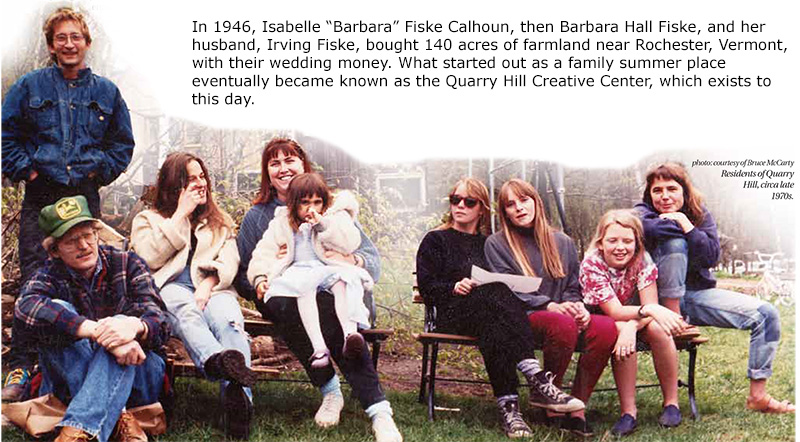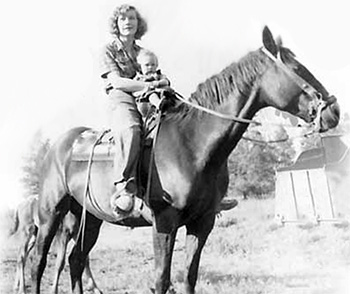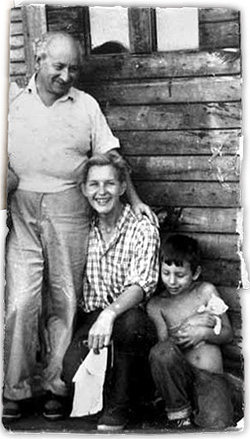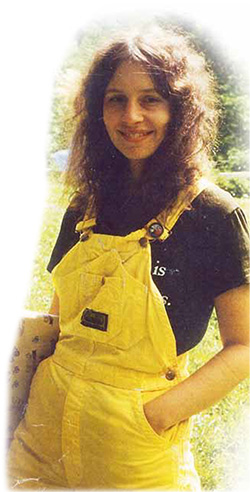| Barbara Fiske Calhoun Cartoonist, Free Spirit, and Cofounder of Quarry Hill Creative Center |
|||||||
| by Cynthia Close | |||||||
 |
|||||||
I knew nothing about the center until reading an obituary in the Burlington Free Press for Calhoun, who died on April 28, 2014.The Free Press identified her as a ““hippie commune’ co-founder.” Having had a longtime interest in alternative communities, this immediately caught my attention, and I began to research what I learned was Vermont’s “oldest alternative living community and artists retreat.” Who was this woman and what had transpired on that property over the course of the last 68 years to earn such a reputation? I discovered that the property is now in the hands of Isabelle (known as “Ladybelle”) McFarlin, Calhoun’s daughter. I called Ladybelle, asking to visit the center and interview her, and was pleasantly surprised by her friendly reception even though she didn’t know me. But Ladybelle warned me that visiting Quarry Hill a few days after a major snowstorm was not the best timing. She made it clear that the road to Quarry Hill might present some challenges. I soon learned Ladybelle’s warning was not overstated when I found myself at the bottom of an icy, snow-covered dirt road, contemplating whether to risk getting stuck somewhere between Quarry Hill and Rochester. Without a four-wheel drive vehicle, it seemed residing in this isolated community during the winter would be close to impossible. I decided to turn back and try visiting in the spring, when the roads would be better.
It was this isolation that first attracted Barbara and Irving Fiske, two bohemian intellectuals from New York City, and inspired them to buy the land. Though city life offered certain benefits, the young couple had become enamored of accounts of turn-of-the-century life in Vermont. The property, which they bought for $1,000, had only one house with no plumbing and a fragile barn. Since life there was primitive, the Fiskes initially only used it as a summer place, where, Ladybelle told me, they could “run around naked” without attracting attention from curious neighbors. As a child, Ladybelle “hardly ever remembers wearing any clothes.” The family—first Barbara and Irving, later with their children, Ladybelle and William—were nomadic. They spent summers in Vermont, but were otherwise on the move, stopping in New York City, where, for a time, Barbara ran The Gallery Gwen in the East Village. She showed her paintings at the gallery along with the work of others, and Irving gave talks on tantra, Zen, Sufism, Hinduism, Christianity, Judaism, and atheism. Then, if they had enough money, the Fiskes traveled to Florida. Money was always an issue. It seemed like they never had much. Nonetheless, Ladybelle, born in 1950, remembers her childhood at Quarry Hill “as beautiful, but at times lonely.” She also recalls feeling like she lived in a cloistered place with a strong fear of being “captured” by the outside world.
The Fiskes were interested in surrounding themselves with like-minded people who were also engaged in the arts. They started inviting their city friends—other artists, writers, and free thinkers—to join them, and gradually an alternative community formed. Vermont has a long history as a welcoming place for utopian, as well as radical, social, economic, and religious movements, going as far back as the 1830s. According to the Vermont Historical Society website, Quarry Hill was one of the first communes where men were actively involved in child rearing. For nearly 50 years women and children held sway at Quarry Hill to an extent not widely accepted in conventional life. Barbara and Irving believed in ideas advocated in the writings of William Blake and Wordsworth that children “held the knowledge of the world” and that they should be completely free to do whatever they wanted, all the time. Children were considered more intelligent than adults.
By the 1960s, the community had attracted a number of youths who were part of the back-to-the-land movement. Although the Fiskes owned the land, they welcomed their visitors to stay and, if they wanted, to build living accommodations on the property. As the years went by, people who built on the property began to assume they had rights to the land. This, however, was not the case, which made selling their homes nearly impossible. Tension grew between the family and the “homesteaders,” finally exploding in a lawsuit in the late 1990s, which Ladybelle refers to as “the big divorce.” It was an unfortunate outgrowth of a philosophy that was based on freedom from rules, where most agreements were oral and children reigned supreme. The lawsuit was ultimately settled. Some of the people involved moved out, and today approximately five of the 20 or so buildings on the property are unoccupied. The land is held in a family-owned corporation, Lyman Hall, Inc., and as Ladybelle reminded me it is, and has really always been, the family “business.” Various people have been invited to rent rooms at a very low rate for as long as they choose, or build houses at their own discretion. Although the houses, and other personal property, remain in the hands of the tenants, the land is owned by the Fiske-Calhoun family, so Quarry Hill has never been a true commune in that regard. Ladybelle Fiske McFarlin has become the spokesperson for Quarry Hill. When I asked her about her mother’s legacy, she said it was her “belief in art as prayer. Art was her religion. She had a deep devotion to creativity.” Ladybelle is the living proof of that legacy and carries the mantle of creativity in her own life on Quarry Hill. She and her husband, Brion McFarlin, manage the property where the original rules—no killing of any kind and no harming children—remain in effect. She has had a fascinating and, at times, difficult life and is working on a memoir. Each year, usually in August, an all-night costume dance party is held at Quarry Hill. In the morning, anyone who is still awake can consume as many blueberry pancakes as they want, made from Brion McFarlin’s secret recipe. This sounds like a much better time to visit Quarry Hill, so I’ve put it on my calendar, no four-wheel drive needed.
|
|||||||
| is a contributing editor to Documentary Magazine and art editor of the literary journal Mud Season Review. She is a co-organizer of the Burlington Writers Workshop and lives in Burlington with her 110-pound “puppy,” Ethel.
|
|||||||







